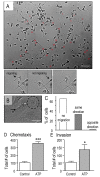Podosomes in migrating microglia: components and matrix degradation
- PMID: 22873355
- PMCID: PMC3423073
- DOI: 10.1186/1742-2094-9-190
Podosomes in migrating microglia: components and matrix degradation
Abstract
Background: To perform their functions during development and after central nervous system injury, the brain's immune cells (microglia) must migrate through dense neuropil and extracellular matrix (ECM), but it is not known how they degrade the ECM. In several cancer cell lines and peripheral cells, small multi-molecular complexes (invadopodia in cancer cells, podosomes in nontumor cells) can both adhere to and dissolve the ECM. Podosomes are tiny multi-molecular structures (0.4 to 1 μm) with a core, rich in F-actin and its regulatory molecules, surrounded by a ring containing adhesion and structural proteins.
Methods: Using rat microglia, we performed several functional assays: live cell imaging for chemokinesis, degradation of the ECM component, fibronectin, and chemotactic invasion through Matrigel™, a basement membrane type of ECM. Fluorescent markers were used with high-resolution microscopy to identify podosomes and their components.
Results: The fan-shaped lamella at the leading edge of migrating microglia contained a large F-actin-rich superstructure composed of many tiny (<1 μm) punctae that were adjacent to the substrate, as expected for cell-matrix contact points. This superstructure (which we call a podonut) was restricted to cells with lamellae, and conversely almost every lamella contained a podonut. Each podonut comprised hundreds of podosomes, which could also be seen individually adjacent to the podonut. Microglial podosomes contained hallmark components of these structures previously seen in several cell types: the plaque protein talin in the ring, and F-actin and actin-related protein (Arp) 2 in the core. In microglia, podosomes were also enriched in phosphotyrosine residues and three tyrosine-kinase-regulated proteins: tyrosine kinase substrate with five Src homology 3 domains (Tks5), phosphorylated caveolin-1, and Nox1 (nicotinamide adenine dinucleotide phosphate oxidase 1). When microglia expressed podonuts, they were able to degrade the ECM components, fibronectin, and Matrigel™.
Conclusion: The discovery of functional podosomes in microglia has broad implications, because migration of these innate immune cells is crucial in the developing brain, after damage, and in disease states involving inflammation and matrix remodeling. Based on the roles of invadosomes in peripheral tissues, we propose that microglia use these complex structures to adhere to and degrade the ECM for efficient migration.
Figures







Similar articles
-
Regulation of podosome formation, microglial migration and invasion by Ca(2+)-signaling molecules expressed in podosomes.J Neuroinflammation. 2012 Nov 17;9:250. doi: 10.1186/1742-2094-9-250. J Neuroinflammation. 2012. PMID: 23158496 Free PMC article.
-
The microglial activation state regulates migration and roles of matrix-dissolving enzymes for invasion.J Neuroinflammation. 2013 Jun 21;10:75. doi: 10.1186/1742-2094-10-75. J Neuroinflammation. 2013. PMID: 23786632 Free PMC article.
-
Podosome-like structures of non-invasive carcinoma cells are replaced in epithelial-mesenchymal transition by actin comet-embedded invadopodia.J Cell Mol Med. 2010 Jun;14(6B):1569-93. doi: 10.1111/j.1582-4934.2009.00868.x. Epub 2009 Jul 28. J Cell Mol Med. 2010. PMID: 19656240 Free PMC article.
-
Coupling between acto-adhesive machinery and ECM degradation in invadosomes.Cell Adh Migr. 2014;8(3):256-62. doi: 10.4161/cam.28558. Cell Adh Migr. 2014. PMID: 24727371 Free PMC article. Review.
-
The interplay between the proteolytic, invasive, and adhesive domains of invadopodia and their roles in cancer invasion.Cell Adh Migr. 2014;8(3):215-25. doi: 10.4161/cam.27842. Cell Adh Migr. 2014. PMID: 24714132 Free PMC article. Review.
Cited by
-
Voltage gated sodium channels in cancer and their potential mechanisms of action.Channels (Austin). 2019 Dec;13(1):400-409. doi: 10.1080/19336950.2019.1666455. Channels (Austin). 2019. PMID: 31510893 Free PMC article.
-
Selective activation of KCa3.1 and CRAC channels by P2Y2 receptors promotes Ca(2+) signaling, store refilling and migration of rat microglial cells.PLoS One. 2013 Apr 19;8(4):e62345. doi: 10.1371/journal.pone.0062345. Print 2013. PLoS One. 2013. PMID: 23620825 Free PMC article.
-
Polygenic risk for traumatic loss-related PTSD in US military veterans: Protective effect of secure attachment style.World J Biol Psychiatry. 2021 Dec;22(10):792-799. doi: 10.1080/15622975.2021.1907721. Epub 2021 May 20. World J Biol Psychiatry. 2021. PMID: 33821766 Free PMC article.
-
VEGF-Trap Modulates Retinal Inflammation in the Murine Oxygen-Induced Retinopathy (OIR) Model.Biomedicines. 2022 Jan 18;10(2):201. doi: 10.3390/biomedicines10020201. Biomedicines. 2022. PMID: 35203414 Free PMC article.
-
Microglia express ABI3 in the brains of Alzheimer's disease and Nasu-Hakola disease.Intractable Rare Dis Res. 2017 Nov;6(4):262-268. doi: 10.5582/irdr.2017.01073. Intractable Rare Dis Res. 2017. PMID: 29259854 Free PMC article.
References
-
- Alberts B, Wilson JH, Hunt T. Molecular Biology of the Cell. 5. Garland Science, New York; 2008.
Publication types
MeSH terms
LinkOut - more resources
Full Text Sources
Miscellaneous

